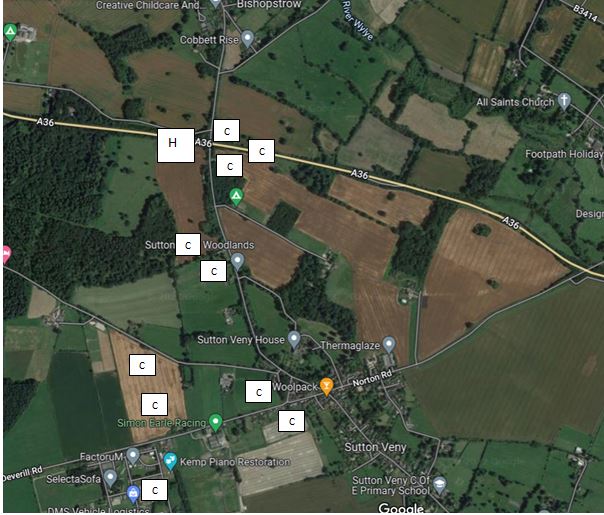Sutton Veny Military Hospital
From Our Contribution
 Sutton Veny with WW1 Hospital and camp locations | |
| History | |
|---|---|
General Information
Sutton Veny and the surrounding villages in the upper Wylye Valley area, was an ideal location to barrack troops in order for them to train prior to deploying to northern France. Supplies arrived via the Salisbury to Warminster railway line, and in November 1914 a railway spur from Heytesbury was laid the few miles to Sutton Veny to convey camp building materials and water for the troops. Approximately 10 Camps were built around Sutton Veny and the first of 10,000 troops British troops belonging to 26th and 34th Division started to arrive in April 1915 to commence their training. Sutton Veny Camp consisted of a number on individual camps including a hospital as shown on the current day aerial photo. C = a camp and H = is the location of the hospital.
Both sides of the Norton Road from Leys Lane were trenches, and troops would live in them for a week at a time with food being brought out as would occur in war. The impact of all these troops on village life was enormous, and both sides realised they had to get onto together. Village women took in soldiers' laundry, and several snack shops and tea huts were built for the mutual benefit of both parties.
In September 1915 the British troops started to leave for France. A camp at Coopers Bottom was used for prisoners of war which started to arrive circa 1916. Also in that year a hospital camp opened for 11 officers and 1261 soldiers between Bishopstrow and Sutton Veny, and in December that year No 1 Australian Command Depot moved to Sutton Veny where it remained until 1919. After the Armistice, No 1 Australian General Hospital was transferred to Sutton Veny where it remained until the end of 1919.
There were also some Australians in Codford with the New Zealand contingent, and there are the graves of 31 Australians in the Codford St Mary New Churchyard. The Australians cut a reproduction of their badge out of the chalk on the hillside above Foxhole Bottom alongside the A36 which can still be seen today. Following the war the Army formed an agricultural training depot at Sutton Veny in order to prepare and train soldiers for their return to civilian life. By mid 1919, 2,000 Australian soldiers had been trained.
Staff
Patients
1916
- William Henry Gibbs 10 - 29 Nov 1916
1917
- † Charles Leonard Lockhart 8 Feb - 5 Mar 1917
- Edwin Patrick Hanrahan 8 Mar - 1 Jul 1917
1918
- Frederick Robert Weedon 1 May - 1 Jun 1918
- Arthur Leworthy Bettenay 3 - 22 May 1918 & 8 Aug - ?? ? 1918
- Leith John Newton Angelo 26 Oct - 9 Nov 1918
- Ernest Ball DCM 6 - 29 Nov 1918